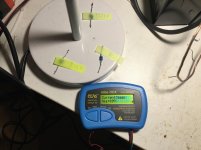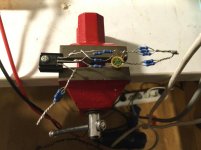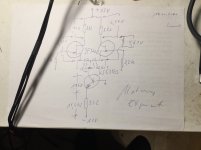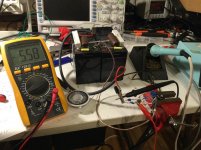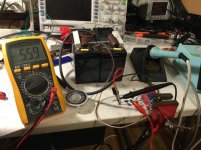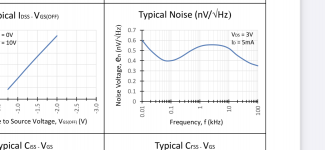CM distortion is most noticeable with Fet imput opamps because of their varying input Capacity with common-mode input Voltage.
In this respect it’s worth mentioning the exeptional OPA 1642 which has a constant input capacitance independent of input voltage.
So CM distortion will be extemely low with this amp.
Hans
.
Yes 100%
I recently refurbished a 32 ch mixing console replacing a few hundred
TL072's with these. Better in every way *and they don't draw huge PS
current.
The opamp distortion white paper by Samuel Groner has measurements and
is very informative although doesn't include later devices such as 1642.
TCD
Or use this and enjoy both advantages.
Jan
There is a (there may be more than one) problem with this circuit (as with any). The propagation delays of the first and second opamp (the impedance correcting opamp) make for a slight delay. This mixed-in delayed signal together with the direct signal will create an new error signal.
In a nutshell this is the problem with 'BALANCED' it is only balanced if all is balanced, that is the left side input, the opamp input, the left side currents and the opamp currents, the propagation delays and all impedances that one can find are equal.
From this you can conclude that 'BALANCED' will be very difficult, if not impossible, in a real world we have to be happy if the results matches our expectation and fulfills our desires.
But that is not fair, in the case at hand we can assume the source output impedance to be near zero, that was the presumption explained earlier.
Frans, we are discussing a diff amp in relation to this MC phono preamp design.
I still don't get what direction you want to go, but fair is not at hand here.
CMRR is most important at higher frequencies, like coming from stray signals that you are referring to.
The OPA1652, as the preferred opamp here, has a 50R open-loop output impedance from 1Khz to 10Mhz.
So look in the sim below what this means for the final CMRR for this opamp having a 18Mhz GBW.
Can you neglect that ? Not at all to my taste.
The second reason I gave is that CM distortion is the lowest with equal impedances as seen from the (+) and the (-) inputs from the diff amp.
So for me the discussion about equal load can be finally closed and only equal impedances are the way to go.
Hans
.
Attachments
There is a (there may be more than one) problem with this circuit (as with any). The propagation delays of the first and second opamp (the impedance correcting opamp) make for a slight delay. This mixed-in delayed signal together with the direct signal will create an new error signal.
In a nutshell this is the problem with 'BALANCED' it is only balanced if all is balanced, that is the left side input, the opamp input, the left side currents and the opamp currents, the propagation delays and all impedances that one can find are equal.
From this you can conclude that 'BALANCED' will be very difficult, if not impossible, in a real world we have to be happy if the results matches our expectation and fulfills our desires.

Jan
Frans, we are discussing a diff amp in relation to this MC phono preamp design.
I still don't get what direction you want to go, but fair is not at hand here.
CMRR is most important at higher frequencies, like coming from stray signals that you are referring to.
The OPA1652, as the preferred opamp here, has a 50R open-loop output impedance from 1Khz to 10Mhz.
So look in the sim below what this means for the final CMRR for this opamp having a 18Mhz GBW.
Can you neglect that ? Not at all to my taste.
The second reason I gave is that CM distortion is the lowest with equal impedances as seen from the (+) and the (-) inputs from the diff amp.
So for me the discussion about equal load can be finally closed and only equal impedances are the way to go.
Hans
.
Hans
You are exactly right. Thumbs up
Stein
One problem remains. Matching the channels.
That makes it really hard to make a commercial product with it.
For private use it is ok. I will take the challenge and build a phono for me.
I came late to this thread and never realized you had a commercial goal in mind with this amp.
In that case I could give you some additional tips.
1) For a commercial product to stand off from the crowd, overload margin @20Khz should be at least 30dB or circa 158mV@20Khz for the 0.5mV@1Khz standard.
But that is easy to achieve.
The current design has the whole Riaa correction in one go, directly after the first stage, meaning that after having amplified the MC signal with the IRF3602, it will be attenuated by 40dB @20Khz, bringing it almost back to the original MC output level.
That’s why the noise performance of the second stage is now so critical.
However when you only apply the 75usec pole at this stage, the signal at 20Khz will only be attenuated by 20dB, making it possible to reduce the gain of the first stage a bit to achieve this 30dB OLM without any noise problem in the second stage.
Then between the second and the third stage the 3180usec and 318usec pole zero correction has to be placed and voila, there you are.
2) the second tip I would give to keep the product top notch, is to give it not only a SE but also a differential output. An OPA1632 instead of the OPA1652 will give you exactly that.
Then a question: what exactly do you mean with “matching the channels”.
Gain is set by resistors and not by the dual fet. Only the input capacity can vary from one fet to another, but an MC amp can easily have an input capacity of 1nF, so by adding the proper cap value up to 1nF this seems no problem.
Hans
@as_audio: I found a nice reference to something we discussed before:
Although the invention has been shown in connection with certain specific embodiments, it will be readily apparent to those skilled in the art that various changes in form and arrangement of parts may be made to suit requirements without departing from the spirit and scope of the invention.
So my quote was not entirely correct ;-)
Jan
Although the invention has been shown in connection with certain specific embodiments, it will be readily apparent to those skilled in the art that various changes in form and arrangement of parts may be made to suit requirements without departing from the spirit and scope of the invention.
So my quote was not entirely correct ;-)
Jan

